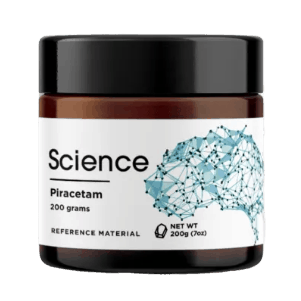
Piracetam and aniracetam are two popular nootropics within the racetam family, known for their cognitive-enhancing properties.
This article provides an in-depth comparison of these two nootropics, examining their key features, mechanisms of action, benefits, side effects, user experiences, and more.
By the end of this article, you’ll have a clear understanding of how piracetam and aniracetam differ and which one might be the best choice for your cognitive enhancement needs.
Table of Contents
What Are the Key Features of Piracetam and Aniracetam?
Piracetam and aniracetam are both synthetic compounds belonging to the racetam family of nootropics.
Key features of piracetam:
- Water-soluble
- Low potency
- Typical dose: 1,600-4,800 mg per day
- Longer half-life (4-5 hours)
Key features of aniracetam:
- Fat-soluble
- Higher potency than piracetam
- Typical dose: 750-1,500 mg per day
- Shorter half-life (1-2 hours)
What Is Piracetam and What Are Its Ingredients?

Piracetam (C6H10N202) is a synthetic water-soluble nootropic compound and the original member of the racetam family. It’s a cyclic derivative of gamma-aminobutyric acid (GABA) and consists of a pyrrolidone nucleus with an acetamide substituent.
What Is Aniracetam and What Are Its Ingredients?

Aniracetam (C12H13N303) is another synthetic nootropic compound within the racetam family. It’s structurally similar to piracetam but with the addition of an anisoyl ring, making it more potent and fat-soluble.
How Do the Ingredients in Piracetam and Aniracetam Compare?
While both piracetam and aniracetam share the pyrrolidone nucleus, aniracetam has an additional anisoyl ring that contributes to its increased potency and fat solubility compared to piracetam. This structural difference also accounts for aniracetam’s distinct cognitive effects and pharmacokinetic properties.
How Do Piracetam and Aniracetam Work for Cognitive Enhancement?
Both piracetam and aniracetam work by modulating various neurotransmitter systems in the brain, primarily the acetylcholine (ACh) and glutamate systems. They are thought to increase the density and function of acetylcholine and glutamate receptors, leading to improved cognitive function.(1)
Piracetam’s mechanism of action:
- Modulates ACh and glutamate receptors
- Increases blood flow and oxygen supply to the brain
- Enhances neuronal membrane fluidity
Aniracetam’s mechanism of action:
- Modulates ACh, glutamate, and dopamine receptors
- Increases blood flow and oxygen supply to the brain
- Enhances neuronal membrane fluidity
- Exhibits anxiolytic (anti-anxiety) effects
What Are the Cognitive Benefits of Using Piracetam?
Piracetam has been shown to improve various aspects of cognitive function, including:
- Memory and learning
- Attention and concentration
- Verbal fluidity and communication
- Mental clarity and alertness
These benefits are attributed to piracetam’s ability to modulate neurotransmitter systems, enhance cerebral blood flow, and protect neurons from oxidative stress.
What Are the Cognitive Benefits of Using Aniracetam?
Aniracetam offers similar cognitive benefits to piracetam, but with some unique advantages:
- Enhanced creativity and holistic thinking
- Improved mood and reduced anxiety
- Increased sensory perception and processing
- Faster information processing and decision-making
Aniracetam’s additional cognitive effects are thought to stem from its modulation of the cholinergic and glutamatergic systems, as well as its anxiolytic properties.
How Do Piracetam and Aniracetam Differ in Their Mechanisms of Action?
While both piracetam and aniracetam work by modulating various neurotransmitter systems, they have some key differences in their mechanisms of action:
- Piracetam primarily acts on the cholinergic system, while aniracetam also modulates the glutamatergic system(2)
- Aniracetam has a higher affinity for AMPA receptors, leading to enhanced glutamatergic transmission(3)
- Aniracetam exhibits anxiolytic effects through its interaction with the serotonergic system(4)
These distinctions in their mechanisms of action contribute to the unique cognitive profiles of piracetam and aniracetam.
What Are the Pros and Cons of Piracetam and Aniracetam?
Piracetam and aniracetam offer various benefits for cognitive enhancement, but they also have some potential drawbacks to consider, such as they may interact with other medications or supplements.
Let’s take a closer look at both nootropic compounds to further asses their safety profiles.
What Are the Advantages and Limitations of Piracetam?
Advantages of piracetam include:
- Well-researched and established nootropic
- Low toxicity and few side effects
- Enhances overall cognitive function
- Affordable and widely available
Limitations of piracetam include:
- May require higher doses for optimal effects
- Effects may be subtle for some users
- Potential interactions with certain medications
What Are the Advantages and Limitations of Aniracetam?
Advantages of aniracetam include:
- More potent than piracetam
- Offers additional cognitive benefits (creativity, mood, sensory perception)
- Fast-acting due to fat solubility
- Anxiolytic properties
Limitations of aniracetam include:
- Less research compared to piracetam
- Higher cost than piracetam
- Shorter half-life, requiring more frequent dosing
- Potential side effects (headache, nausea, anxiety)
How Do Users Experience Piracetam and Aniracetam?
User experiences with piracetam and aniracetam vary, but many report positive effects on cognitive function, mood, and overall well-being.
What Are Common User Experiences and Testimonials for Piracetam?
Users often report the following experiences with piracetam:
- Enhanced memory and learning ability
- Improved verbal fluency and communication skills
- Increased focus and mental clarity
- Reduced brain fog and mental fatigue
One user shared, “Piracetam has been a game-changer for me. I’ve noticed a significant improvement in my memory and ability to learn new information quickly. It’s also helped me communicate my thoughts more effectively.“
What Are Common User Experiences and Testimonials for Aniracetam?
Users frequently report these experiences with aniracetam:
- Improved memory and cognitive function
- Enhanced mood and reduced anxiety
- Increased creativity and motivation
- Improved sensory perception
A user stated, “Aniracetam has become my go-to nootropic for boosting my mood and creativity. It helps me think outside the box and tackle challenges with a more positive outlook. The cognitive benefits are a nice bonus too!“
How Do Individual Responses to Piracetam and Aniracetam Vary?
Individual responses to piracetam and aniracetam can vary due to factors such as:
- Genetics and brain chemistry
- Age and overall health status
- Dosage and duration of use
- Combination with other nootropics or supplements
Some users may find one nootropic more effective than the other, while some may benefit from using both in a stack. Experimentation and self-observation are key to determining the best nootropic for individual needs.
What Are the Side Effects and Safety Profiles of Piracetam and Aniracetam?
Piracetam has a long history of safe use, with few reported severe side effects. Aniracetam, while considered safe, has a shorter track record and may interact with other medications or supplements.
What Side Effects Have Been Reported with Piracetam?
Piracetam is generally well-tolerated, but some users may experience mild side effects such as:
- Headache
- Nausea
- Insomnia
- Agitation or irritability
These side effects are usually transient and can be mitigated by adjusting the dosage or taking piracetam with food.
What Side Effects Have Been Reported with Aniracetam?
Aniracetam may cause similar side effects to piracetam but with a slightly higher incidence due to its increased potency. Additional side effects may include:
- Anxiety or restlessness
- Gastrointestinal discomfort
- Dizziness or vertigo
- Jaw tension or teeth-grinding
As with piracetam, these side effects can often be managed by adjusting the dosage or timing of aniracetam intake.
How Do the Safety Profiles of Piracetam and Aniracetam Compare?
Both piracetam and aniracetam have relatively good safety profiles when used at recommended doses. However, some key differences include:
- Piracetam has a longer history of use and more extensive safety data
- Aniracetam may have a slightly higher risk of side effects due to its potency
- Aniracetam may interact with a broader range of medications due to its effects on multiple neurotransmitter systems
As with any nootropic, it’s essential to consult with a healthcare professional before starting use, especially if you have pre-existing health conditions or are taking medications.
In What Situations Should You Choose Piracetam and Aniracetam and Vice Versa?
Choosing between piracetam and aniracetam depends on your specific goals, preferences, and individual response to each nootropic.
When Is Piracetam the Preferred Choice?
Piracetam may be the preferred choice in situations such as:
- Beginner nootropic users seeking a well-tolerated and established cognitive enhancer
- Individuals primarily looking to improve memory, learning, and mental clarity
- Those sensitive to the stimulatory effects of more potent nootropics
- Individuals on a budget, as piracetam, is generally more affordable than aniracetam
When Is Aniracetam the Preferred Choice?
Aniracetam may be the preferred choice in situations such as:
- Experienced nootropic users seeking a more potent and versatile cognitive enhancer
- Individuals looking to enhance creativity, mood, and sensory perception in addition to general cognitive function
- Those with anxiety or stress who may benefit from aniracetam’s anxiolytic properties
- Individuals who prefer a faster-acting nootropic due to aniracetam’s fat solubility
How Do Piracetam and Aniracetam Compare in Terms of Cost and Value?
Piracetam is generally more affordable than aniracetam, mainly due to its lower potency and wider availability. However, aniracetam may offer better value for some users, as its higher potency means fewer doses are needed to achieve the desired effects.
What Are the Price Points of Piracetam and Aniracetam?
Piracetam is generally more affordable than aniracetam. Prices can vary depending on the brand, quantity, and location, but on average:
- Piracetam: $0.50 – $1.00 per gram
- Aniracetam: $2.00 – $4.00 per gram
These prices are based on powder form, and capsule or tablet forms may be more expensive.
How Do the Costs of Piracetam and Aniracetam Compare in Terms of Value for Money?
While aniracetam is more expensive than piracetam, it’s also more potent and offers additional cognitive benefits.
In terms of value for money, Piracetam offers a cost-effective option for general cognitive enhancement, but may require higher doses for optimal effects.
Aniracetam provides a more potent and versatile nootropic experience, which may justify its higher cost for some users.
How to Choose Between Piracetam and Aniracetam Based on Personal Needs?
To choose between piracetam and aniracetam, consider your personal needs, goals, and preferences.
What Factors Should Be Considered When Choosing Between Piracetam or Aniracetam?
When choosing between piracetam and aniracetam, consider the following factors:
- Your specific cognitive goals (memory, creativity, mood, etc.)
- Your experience level with nootropics
- Your sensitivity to stimulants and potential side effects
- Your budget and willingness to invest in a more expensive nootropic
- Your preferred dosing schedule (aniracetam may require more frequent doses)
How Can You Determine Which Nootropic Is Right for Your Specific Needs?
To determine which nootropic is right for you:
- Clearly define your cognitive goals and priorities.
- Research the specific effects and mechanisms of action of each nootropic.
- Start with a lower dose of your chosen nootropic and assess your individual response.
- Keep a log of your experiences, including benefits, side effects, and dosage.
- Be open to experimenting with different nootropics or combinations to find what works best for you.
Remember, every individual’s brain chemistry and response to nootropics is unique. What works for one person may not work for another, so it’s crucial to approach nootropic use as a self-experiment and listen to your body’s feedback.
What Are the Long-Term Effects and Benefits of Using Piracetam and Aniracetam?
Long-term use of piracetam and aniracetam may offer sustained cognitive benefits, such as improved memory, learning, and overall brain function. However, more research is needed to fully understand the long-term effects and potential risks associated with extended use.
What Long-Term Cognitive Benefits Can Be Expected from Piracetam?
Long-term use of piracetam has been associated with the following cognitive benefits:
- Sustained improvements in memory, learning, and recall
- Enhanced mental clarity, focus, and information processing
- Increased verbal fluency and communication skills
- Potential neuroprotective effects against age-related cognitive decline
While more research is needed on the long-term effects of piracetam, many users report sustained cognitive benefits with regular use.
What Long-Term Cognitive Benefits Can Be Expected from Aniracetam?
Aniracetam’s long-term cognitive benefits may include:
- Sustained enhancements in creativity, problem-solving, and holistic thinking
- Improved mood, reduced anxiety, and increased resilience to stress
- Heightened sensory perception and appreciation of experiences
- Potential neuroprotective effects against age-related cognitive decline and neurodegeneration
As with piracetam, more long-term studies are needed to fully understand aniracetam’s lasting effects on cognitive function.
How Can You Optimize the Use of Piracetam and Aniracetam for Maximum Benefit?
To optimize the use of piracetam and aniracetam for maximum benefit, remember to follow recommended dosages, stay consistent and combine supplementation with a healthy lifestyle. Additionally, consider the following tips:
What Are the Best Practices for Using Piracetam?
To optimize the use of piracetam for maximum benefit:
- Start with a low dose (1.2-4.8 grams per day) and gradually increase as needed
- Divide your daily dose into 2-3 smaller doses for consistent effects
- Take piracetam with a source of choline (e.g., Alpha-GPC, CDP-choline) to prevent headaches and enhance cognitive effects
- Use piracetam consistently for at least 2-4 weeks to assess its full effects
- Cycle piracetam use (e.g., 3 weeks on, 1 week off) to maintain sensitivity and prevent tolerance
What Are the Best Practices for Using Aniracetam?
To optimize the use of aniracetam for maximum benefit:
- Start with a low dose (750-1,500 mg per day) and adjust as needed
- Divide your daily dose into 2-3 smaller doses due to aniracetam’s shorter half-life
- Take aniracetam with a fat source to enhance absorption and bioavailability
- Use aniracetam consistently for at least 2-4 weeks to assess its full effects
- Cycle aniracetam use (e.g., 3 weeks on, 1 week off) to maintain sensitivity and prevent tolerance
Additionally, experiment with combining piracetam or aniracetam with other nootropics, such as caffeine, L-theanine, or Noopept, to create synergistic effects and further enhance cognitive performance.
Which Nootropic Supplement Is Better: Piracetam or Aniracetam?
Piracetam may be the better choice for those new to nootropics, seeking general cognitive enhancement, or looking for a more affordable option. Aniracetam may be preferred by experienced users seeking a more potent and versatile nootropic, or those looking to specifically enhance creativity, mood, and sensory perception.
The best approach is to experiment with each nootropic individually, starting with low doses and carefully monitoring your response. Keep a log of your experiences, and don’t hesitate to try different dosages, schedules, or combinations to find what works best for you.
Remember, nootropics are just one piece of the cognitive enhancement puzzle. A healthy lifestyle, including regular exercise, a balanced diet, adequate sleep, and stress management, is essential for optimizing brain function and getting the most out of your nootropic use.
- Satoh, Ryusei et al. “Effects of Smart Drugs on Cholinergic System and Non-Neuronal Acetylcholine in the Mouse Hippocampus: Histopathological Approach.” Journal of clinical medicine vol. 11,12 3310. 9 Jun. 2022, doi:10.3390/jcm11123310↩
- Winblad, Bengt. “Piracetam: a review of pharmacological properties and clinical uses.” CNS drug reviews vol. 11,2 (2005): 169-82. doi:10.1111/j.1527-3458.2005.tb00268.x↩
- Xiao, P et al. “Selective effects of aniracetam across receptor types and forms of synaptic facilitation in hippocampus.” Hippocampus vol. 1,4 (1991): 373-80. doi:10.1002/hipo.450010405↩
- Nakamura, K, and M Kurasawa. “Anxiolytic effects of aniracetam in three different mouse models of anxiety and the underlying mechanism.” European journal of pharmacology vol. 420,1 (2001): 33-43. doi:10.1016/s0014-2999(01)01005-6↩
